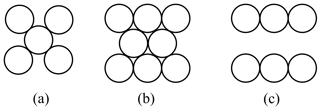Crystal Lattices and Unit Cells
Crystal Lattices and Unit Cells: Overview
This topic covers concepts, such as, Crystal Lattice, Unit Cell, Three Types of Cubic Crystal System & Unit Cell Parameters etc.
Important Questions on Crystal Lattices and Unit Cells
The figures given below show the location of atoms in three crystallographic planes in a lattice.

The planes in the unit cell have been highlighted in the diagram below choose the correct option.

Chromium metal crystallizes with a body centred cubic lattice. The length of the unit cell edge is found to be 287 pm. What would be the density of chromium in ?
The edge length of unit cell of a metal having molecular weight is which crystallizes in cubic lattice. If the density is then the radius of metal atom will be (in pm):
The density of mercury is 13.6 g ml-1. The approximate diameter of an atom of mercury assuming that each atom is occupying a cube of edge length equal to the diameter of the mercury atom is
The coordination number of a metal crystallizing in a hexagonal close-packed structure is:
Draw the schematic representation of lattice points in primitive unit cells.
How many types of centred unit cells are there?
_____ unit cells have points at the corners as well as at some other positions.
Give one example of a solid having rhombohedral crystal system.
What do you mean by Rhombohedral crystal system?
Calculate the packing efficiency in case of metal crystal for simple cubic unit cell.
Explain how the particles are arranged in the simple cubic lattice.
There are a total of twelve lattice points in an end-centred unit cell.
The number of lattice points in an end-centred unit cell are:
How many lattice points are there in an end-centred unit cell?
Draw a schematic representation of lattice points in end-centred unit cell.
Define an end-centred unit cell.
A cubic solid is made up of two elements and . Atoms of are present at the corners of the cube and atoms of are present at body centre. What is the formula of the compound ?
In the cell is shared equally by how many unit cells?
Write binding forces present in the Network solids along with giving an example.
